Among the representatives of the tropical fauna, there are a lot of truly beautiful animals, often painted in surprisingly bright colors. Perhaps this is due to the fact that the very nature of the tropics is distinguished by a riot of colors. For example, in tropical latitudes, exotic birds painted in incredible shades are found, as well as exotic lizards, one of which will be discussed in this article.
Appearance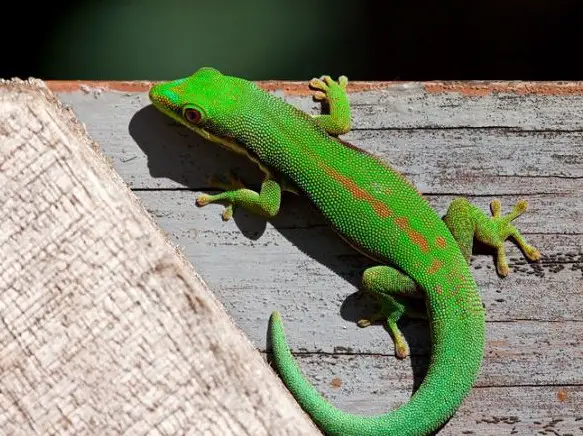
Gold-Dust Day Geckos are usually not very large in size – 18-23 cm in length. But there are species that grow up to 30 cm. In addition to bright red spots on the sides along the back, the reptile has wide red stripes on the sides of the head, turning into the corresponding edging of the eyes. The same large red spot is located on top of the head of some subspecies of Gold-Dust Day Gecko, and on the back, these spots tend to merge into short transverse stripes.
These reptiles move very actively, despite the absence of claws on their paws and, due to their diurnal lifestyle, have a round pupil.
Habitat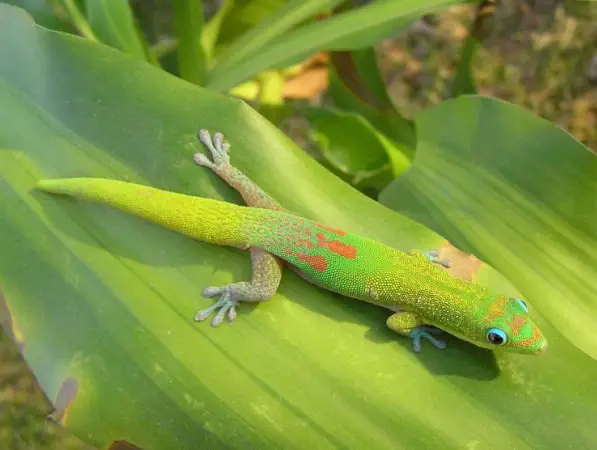
The coast of northwestern and northeastern Madagascar and adjacent islands, Comoros, Hawaii.
In nature, Gold-Dust Day Gecko lives in areas with high humidity (annual rainfall 900-1500 ml). This reptile can be found on tree trunks, stone walls, and inside buildings.
Lifestyle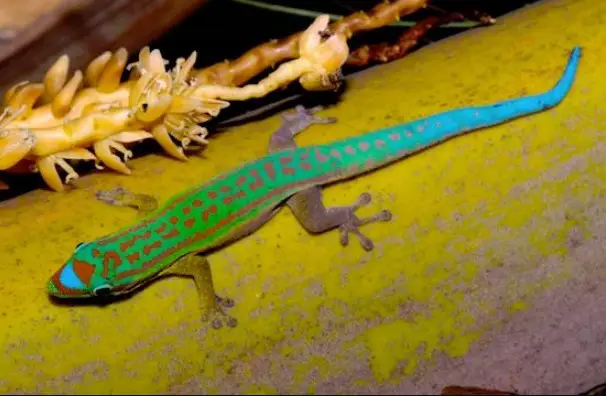
Gold-Dust Day Gecko is diurnal, spending most of its time in trees. Their color changes depending on temperature and lighting.
In nature, these lizards feed on insects and invertebrates (mainly), as well as various fruits and nectar.
Reproduction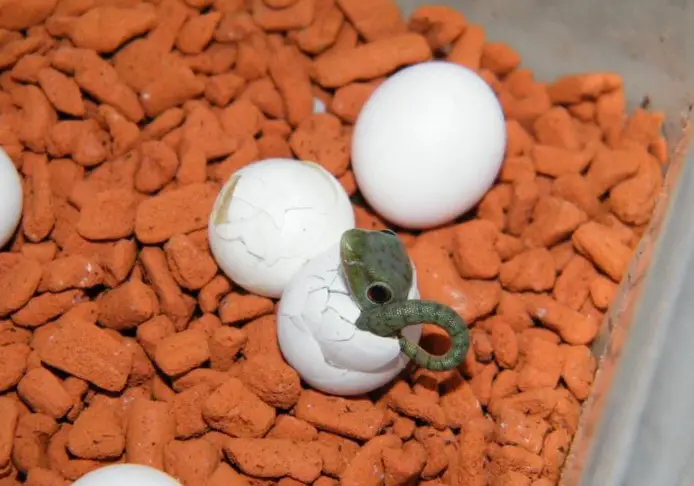
Males are larger than females, and females also (during the breeding season) have dense swellings on the throat in the cheeks on both sides, the so-called. “lime warehouses” where calcium is deposited. The breeding season runs from March to November.
Pregnancy lasts 3-8 weeks. The female usually lays two eggs. After laying, she holds them with her hind legs until (sometimes it takes up to 3 hours) until the shell of the eggs becomes hard. As soon as the female lays eggs (at the base of the leaves, in the bamboo cavity, under the bark, in the sand), she is again ready for breeding. If the female does not lay eggs in a secluded place, then, most likely, the eggs are not fertilized and the female can eat them. A female can make 6 clutches per year. The incubation period lasts about 60-65 days at a temperature of 25-28’C (humidity 60-80%). The higher the incubation temperature, the more males will be born. Newborn lizards are about 4 cm long.
Keeping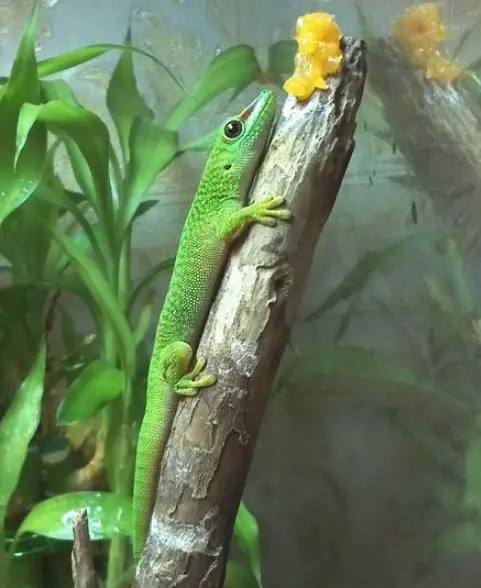
To keep a pair of Day Geckos, you will need a vertical terrarium with a volume of 75 liters or more (dimensions 30x30x40 cm or 40x60x80 cm) with a mesh cover.
A mix of soil and wood shavings, as well as peat, is used as a substrate. A lot of sturdy plants and sticks are placed in the terrarium, on which the Day Geckos will climb. Suitable plants: Orchids, Dracaena, Bamboo, Philodendron, Scindapsus (Potos), Bromeliads.
Daytime temperatures should be between 27-29˚C and can drop to 21-22˚C at night. Better yet, provide 24-26 C in the terrarium and 30-35 ˚C in the “hot spot” – a small area where Gecko can come to warm up. In winter, it is recommended to lower the temperature by a few degrees.
The duration of daylight hours from spring to autumn is 14 hours; in the winter months, it is enough to illuminate the terrarium for 10 hours a day. The decrease in temperature and daylight in winter gives Geckos an opportunity to relax. This is especially true for females who stop producing eggs in winter. A Day Geckos ultraviolet lamp is necessary; under ultraviolet light, the reptile produces vitamin D3. This vitamin allows reptiles to absorb calcium from food. Day Geckos should be heated from above, from the lamp.
Feeding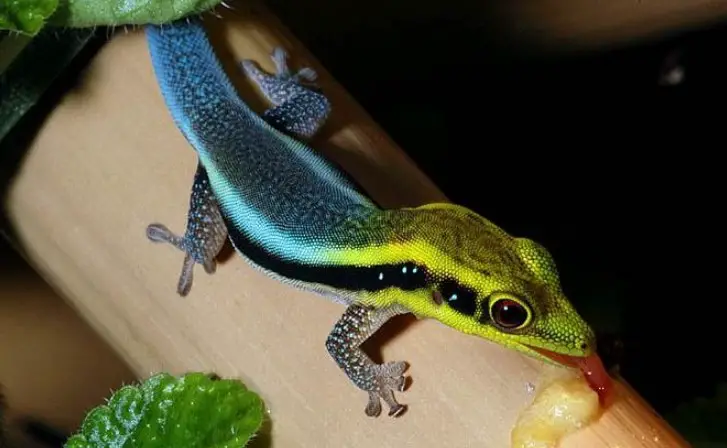
Geckos love to eat insects and fruits. You can advise this feeding regimen: give insects twice a week, and once fruit. Overfeeding Geckos is not worth it. An overweight lizard produces fewer eggs and dies faster. A German firm has been surveying dead terrarium animals for several years, including the Geckos. It turned out that in 85% of cases the cause of death was fatty liver hepatosis caused by excessive nutrition or a monotonous diet.
Health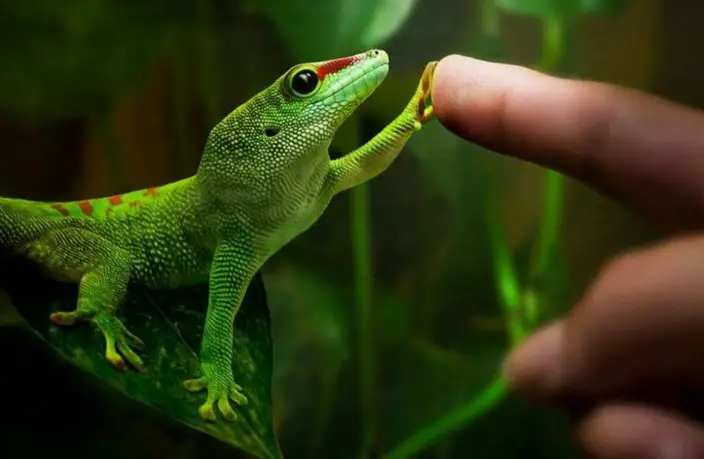
With proper health care, Gold-Dust Day Gecko is not a big deal. First, as mentioned above, it is important not to overfeed. Secondly, it is imperative to give vitamin-calcium supplements every 2-3 meals. Third, the warm and humid environment of the terrarium is favorable for the development of bacteria and fungi that cause skin and lung infections. To avoid this kind of trouble, the terrarium must be well ventilated. At the same time, it should not be allowed to dry in the terrarium. Low humidity will cause shedding problems that can be fatal.

